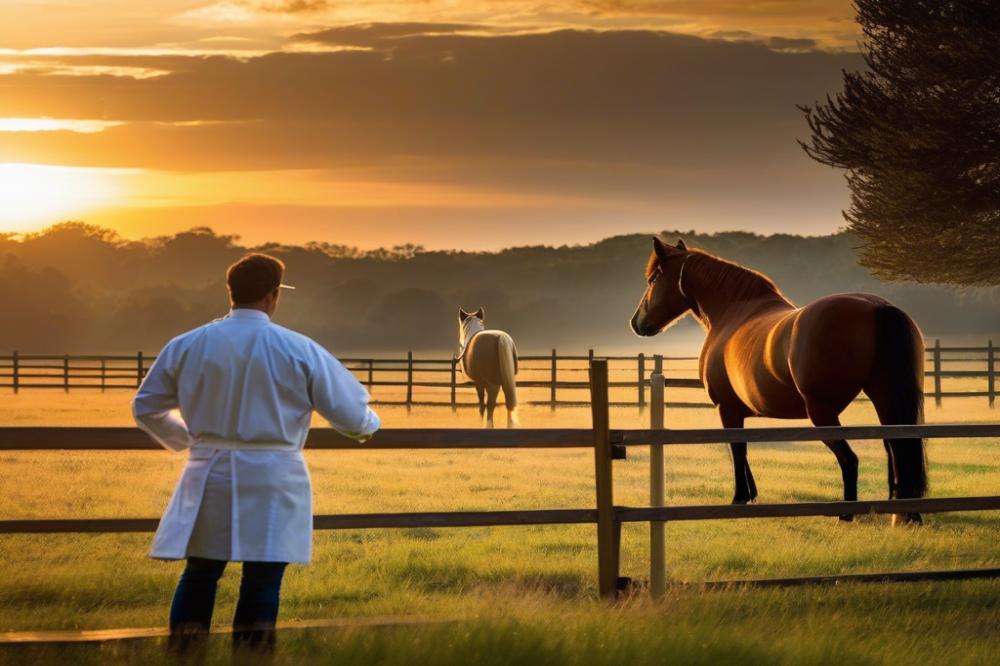Advances in Equine Veterinary Medicine Treating Common Ailments
The world of horse care is experiencing a transformation, as advances in veterinary medicine introduce innovative approaches to treating common ailments. Medical techniques aimed at preserving Horse Health have evolved significantly in recent years. Today’s equine practitioners combine traditional practices with cutting-edge technologies, fostering a new era of recovery and prevention.
Monitoring equine athletes has never been easier. Wearable technology allows for real-time assessment of a horse’s performance and well-being. With such tools, veterinarians can detect subtle changes in behavior and physiology before they escalate into major issues. Early intervention is becoming the norm, which can save both time and resources.
Therapies range from regenerative medicine, including stem cell treatments, to advanced imaging techniques for diagnostics. A variety of methods are now at the disposal of those caring for horses, offering a greater chance of success in challenging cases. In addition, preventive care has taken on new significance. Vaccination schedules and nutritional strategies are tailored to each individual, promoting optimal health and performance.
Another significant breakthrough is the rise of mobile veterinary services. Access to care increases, especially in remote areas where traditional veterinary clinics may be lacking. This shift allows for timely intervention, crucial for health and safety. Understanding the importance of continuous care remains paramount within equine communities.
As the field continues to grow, collaboration among specialists becomes vital. Vets, farriers, and trainers are increasingly working together to develop comprehensive care plans for horses. This holistic approach emphasizes the interconnectedness of equine well-being, aligning expertise from varied backgrounds.
One must appreciate that each horse is unique. Their needs differ based on breed, purpose, and individual history. This very individuality demands specialized attention in both treatment and preventive strategies. The journey toward the best health outcomes hinges on collaboration, innovation, and an ever-expanding knowledge base.
In the realm of veterinary care, it is clear that understanding the horse’s needs is not simply about eliminating ailments but enhancing overall life quality. The strides taken in Equine Veterinary Medicine are paving the way for a new understanding of Horse Health and stewardship. Just as a winding trail leads through a familiar countryside, the future holds promise for both equine companions and their caretakers.
Advances in Equine Veterinary Medicine

The field of veterinary treatments for horses has seen remarkable transformations in recent years. Enhanced methodologies have emerged, providing practitioners with new insights and tools for improving equine health. A significant progress lies in the development of minimally invasive techniques. Surgeries that once required extensive recovery times can now be performed using scopes and lasers. This reduces pain and speeds up return to normal activities for the horse.
Moreover, the integration of technology within equine care has been nothing short of revolutionary. Wearable devices designed to monitor vital signs and activity levels are now commonplace. Owners can receive real-time updates, allowing them to keep a close watch on their horse’s well-being. Shifts in data collection have enabled veterinarians to make educated assessments more efficiently. Imaging techniques like MRI and ultrasound have also improved drastically, yielding clearer visuals that aid in accurate diagnostics.
The impact of these innovations on diagnosing and treating horse diseases is profound. Veterinarians can pinpoint conditions or injuries that were once difficult to detect. This not only saves time but often allows for earlier intervention, which can be crucial. Enhanced understanding of diseases complements these advancements. Now, practitioners can prescribe precisely tailored treatments based on individual assessments, often drawing from a mix of holistic and conventional methods.
New medical therapies, such as regenerative medicine, are reshaping how ailments are approached. Procedures like stem cell therapy show promise in treating injuries that were previously career-ending. Horses now have a chance for recovery that was unimaginable not long ago. Also noteworthy is the emphasis on preventive care. Vaccination protocols and nutritional advancements have become integral to routine management, enhancing overall longevity and health.
As veterinarians strive to offer comprehensive care, collaboration remains essential. Specialists from various fields often work hand-in-hand, sharing knowledge and expertise. This multi-disciplinary approach enriches the treatment landscape for all equine maladies. Not to mention, a horse’s unique personality can influence treatment plans, making the relationship with its handler significant in recovery.
Communication plays a key role here. Educating owners on the importance of consistent monitoring and prompt action when issues arise continues to be a priority. Seeing firsthand how their horse responds to different treatments fosters trust in the veterinary process. It’s often said that an ounce of prevention is worth a pound of cure, and this rings true in the world of equines.
In summary, advancements in equine veterinary treatments have markedly improved outcomes. Combining established practices with modern techniques offers a brighter future for the care of horses. While challenges remain, the focus on technology and collaboration signifies a promising trajectory for addressing equine health needs.
Common Ailments in Horses

In the world of equestrian care, various ailments afflict horses, from the most minor inconveniences to severe health threats. Lameness ranks among the most prevalent issues. Whether it’s a minor strain or a severe joint condition, lameness can sideline a horse, affecting its ability to perform. Another common complaint, colic, manifests as severe abdominal pain, often causing distress for both horse and owner. Symptoms can range from mild discomfort to life-threatening conditions, requiring prompt veterinary attention.
Equine respiratory diseases regularly affect horses, particularly those kept in close quarters. Conditions like heaves and pneumonia can impede breathing and impact overall stamina. Skin ailments, such as dermatitis and fungal infections, crop up frequently, often exacerbated by environmental factors or unsanitary living conditions. These ailments can lead to discomfort, secondary infections, and in severe cases, systemic illness.
These health issues are not merely inconveniences; they carry a hefty weight in terms of welfare and productivity. The economic impact stares owners in the face, as medical treatments, loss of training, and decreased performance mushroom into substantial expenses. A horse with lameness or respiratory distress is more than just a sick animal; it represents lost potential and din of neglected dreams for owners and riders alike.
With all these factors at play, early detection becomes paramount. Just like with humans, the sooner a problem is identified, the easier it is to treat. Regular check-ups and attentive monitoring can catch signs of rising trouble before they escalate. Owners must cultivate a keen eye, observing not only behavior but also subtle changes in movement or appetite. Preventive care can transform horsekeeping from a reactive to a proactive endeavor, enabling issues to be tackled head-on.
Preventive measures, like maintaining an appropriate vaccination schedule and proper nutritional support, lay a foundation for a healthier horse. Keeping bedding clean and ensuring adequate ventilation in stables reduces the risk of respiratory infections. Collaborating with knowledgeable equine experts fosters an environment of health and longevity for these majestic animals. Ultimately, having a robust health program paves the way for happier, healthier horses, allowing them to thrive under the challenges of daily life.
Breakthroughs in Equine Surgery

Overview of Surgical Innovations in Equine Medicine
Recent years have brought forth a wave of innovations in the realm of equine surgery. Techniques once deemed risky have transformed into standard procedures, making the surgical landscape more accessible. Surgeons now regularly perform arthroscopic surgeries, allowing for minimally invasive interventions. This change benefits both horses and their owners, as recovery times are significantly shorter. Laser surgery has also carved a niche, reducing bleeding and minimizing damage to surrounding tissues. Advanced imaging techniques, like MRI and CT scans, provide detailed views of equine anatomy. As a result, veterinarians can pinpoint issues before they escalate.
Case Studies of Successful Surgical Interventions
Real-world applications of these innovations have amazed audiences. Whether dealing with a routine colic surgery or a complex fracture repair, the surgical outcomes speak volumes. Success stories abound in clinic files, narrating tales of horses returning to their beloved routines. Riders beam with pride as their equine partners regain strength following hip surgeries. In each instance, precision and skill create a symphony of healing. Each operation brings its own set of challenges, yet the dedication displayed by Veterinary teams often leads to remarkable recoveries.
Role of Rehabilitation in Recovery from Surgery
Recovery does not end with surgery; rather, it marks the beginning of a journey. Rehabilitation plays an essential part in ensuring horses return to their previous forms. Gentle stretching exercises and tailored plans enable them to regain flexibility and strength. Owners often marvel at the transformation during this phase. Not only do horses benefit physically, but they also enjoy the engagement and interaction with their caregivers. Each session feels like an adventure as both horse and handler navigate the path to recovery. Creating a bond during rehab enriches the experience, often developing trust and camaraderie. Visualization of the end goal motivates all involved. Healing is a team sport, after all.
Importance of Hoof Health and Equine Nutrition
The health of a horse’s hooves is intricately tied to its overall well-being. Neglect in this area can lead to lameness, pain, and a cascade of other problems. Strong, well-maintained hooves are essential for a horse’s mobility and performance. Imagine trying to walk on a road covered in potholes. The discomfort and frustration are palpable. That’s how horses feel without proper hoof care.
Advancements in equine nutrition have evolved significantly, offering targeted solutions for common ailments. New formulations now contain precise combinations of vitamins and minerals designed to bolster hoof integrity. Proper dietary management plays a pivotal role in promoting resilient hooves. Whole grains fortified with essential fatty acids can nourish the hoof wall, yielding better quality growth.
Preventive care is vital in this equation. Regular hoof trimming and shoeing are not merely routine but are critical practices for maintaining hoof structure. Routine inspections can catch issues before they worsen, much like a dentist catching a cavity in its early stages. Implementing an effective hoof care program is part of a horse owner’s responsibility. Knowledge about a horse’s dietary needs can prevent ailments down the line, ensuring a long and healthy life.
When it comes to nutrition, one must also consider the unique needs of the horse’s environment and lifestyle. For example, a horse in heavy training might have dramatically different nutritional requirements compared to a laid-back companion. Understanding these differences allows owners to tailor their feeding regimen. Healthy hooves often result from a balanced diet that supports the entire body, proving once again that you are what you eat.
Anecdotes abound in the stable about horses transforming due to improved nutrition and hoof care. Owners have noted remarkable changes in their horses’ energy levels and general health after paying closer attention to these crucial factors. A horse that walks comfortably is a horse that thrives; it’s a delicate balance but one easily tipped in favor of health.
Finally, integrating a hooves-first approach with an understanding of nutrition can make all the difference. Much like a well-oiled machine, every part must function properly for the entire system to work effectively. Developing a comprehensive care strategy can be the key to unlocking performance and longevity. Consider this a partnership between a horse and its owner, built on trust, attention, and of course, a great diet!
Veterinary Technology in equine care
The landscape of veterinary technology has transformed how equine professionals address health challenges in horses. A wide array of cutting-edge tools is now at their disposal. Innovations such as advanced imaging techniques and telemedicine platforms are changing the game. These advancements are no longer a luxury; they have become essential in modern practices.
Diagnostic tools allow veterinarians to visualize issues beneath the surface. For instance, high-definition ultrasound and digital radiography provide clarity that once required invasive methods. Detection of injuries and conditions is quicker and more precise. Imagine spotting a hairline fracture that would have gone unnoticed just a few years ago. That’s the magic of technology at work.
Treatment also benefits from these technological strides. Laser therapy, for example, is a non-invasive option that promotes healing and reduces pain. Horses recovering from surgery can bounce back faster with these methods. Remote monitoring devices, while perhaps not as glamorous, play a crucial role in ongoing care. They can watch vital signs without the constant presence of a vet, allowing for real-time alerts when something isn’t right.
Preventive care is where you’ll find one of technology’s most vital contributions. Regular health assessments have moved from traditional check-ups to proactive monitoring. Wearable devices can track an equine athlete’s performance and health metrics, ensuring any signs of trouble are detected early. This kind of vigilance can make all the difference in a successful training regimen.
Between wearables and apps for health monitoring, horse owners are better informed than ever. Technology allows for seamless communication between owners and vets. This dynamic duo can address concerns promptly, enhancing the overall experience for all involved. As technology evolves, so too does the relationship between horse and caregiver.
No longer confined to physical locations, veterinary consultations can now happen from the comfort of home. Video calls replace the stressful trip to the clinic, especially for anxious horses. That stress-free interaction leads to happier horses—and let’s face it, happier owners too!
Simply put, the integration of technology in equine care is revolutionizing treatment and maintenance practices. As these advancements continue to develop, equine health will surely see improvements. The road ahead is promising, dotted with potential that enhances both care and outcomes.
Looking Ahead in Veterinary Practices
Improvements in treatment methods have greatly influenced the care provided to our equine friends. The integration of advanced technologies and innovative practices reflects an enhanced understanding of animal physiology and behavior. Each ailment, whether it involves the musculoskeletal system or gastrointestinal tract, is met with a tailored approach that recognizes the specific needs of each horse. Veterinarians now employ sophisticated imaging techniques, such as ultrasound and MRI, to pinpoint issues with remarkable clarity.
Progress in preventative care strategies emphasizes the importance of routine check-ups. Detecting potential problems early can save much distress and expense down the line. Likewise, the emphasis on nutrition has never been stronger. Just as the saying goes, “You are what you eat,” the same applies to equines. The right diet can mitigate various health problems. For more on this topic, one can explore our comprehensive guide on equine care.
Emerging therapies, such as regenerative medicine, open new avenues for rehabilitation. Stem cell research and platelet-rich plasma treatments allow for healing that was once thought impossible. These approaches harness the body’s natural healing processes, offering hope even for severe injuries. Thus, equestrian professionals have a wealth of resources at their disposal.
As we reflect upon these advancements, it’s essential to recognize the collaborative efforts within the veterinary community. Knowledge sharing and continuous education empower practitioners to stay ahead of trends. Keeping up with recent developments not only benefits the animals but also enriches the lives of those who care for them. A focus on comprehensive wellness encompasses both physical health and emotional stability, which is vital for optimal performance.
Finally, the journey toward excellence in care remains ongoing. With each case, professionals learn and adapt, further enriching their practice. Riding the wave of these innovations requires community commitment. Engage with fellow horse owners and professionals to ensure the best outcomes. If interested in more insights or services, consider signing up [here](https:www.virtualheadquarters.com/signup.html). Embrace the transformation in veterinary treatments, for every horse deserves the finest care. The horizon looks bright for all involved.



